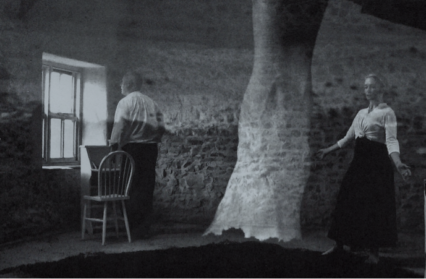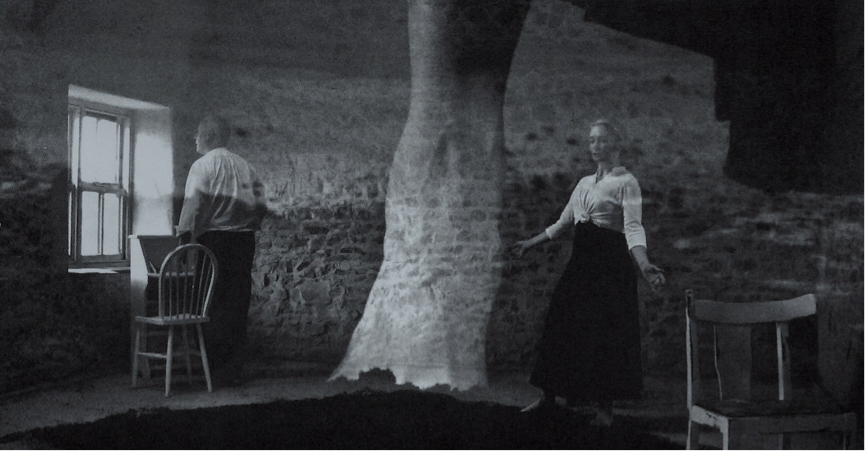Phillip Zarrilli takes us “…beneath the surface” of The Llanarth Group’s Told by the Wind an intercultural experiment in dramaturgy and aesthetics.
After touring internationally to Tokyo, Chicago, Berlin, Poland and Portugal between 2009 and 2013, The Llanarth Group’s Told by the Wind returns to Wales for performances between October 9-13. Told will have a natural light preview (09 October 3p.m.) at Small World Theatre (Cardigan), and returns to Chapter Arts Centre (12-13 October) where the performance premiered in 2010. Co-created by award-winning playwright/dramaturg, Kaite O’Reilly, dancer/choreographer Jo Shapland, and Artistic Director/performer Phillip Zarrilli, Told by the Wind combines movement, dance, minimal fragmentary text, subtle lighting by Ace McCarron, and silence to create a unique experience for audiences.
Responding to the unique experience of Told by the Wind, Elisabeth Mahoney of THE GUARDIAN described the performance as ‘…hypnotic…[with] a haunting, painterly beauty…[and] the astringent purity of a haiku poem…’ Similarly the critics in Chicago at SEE CHICAGO DANCE and CHICAGO TIME OUT described the performance respectively as ‘…minimal…mesmerizing…evoking both later T.S. Eliot and haiku’, and ‘…Beckettian magnetic poetry…all dropped like shapeless stones into a moonlit lake of silence…’
I briefly explore here the subtle terrain ‘beneath the surface’ of what is visible onstage in performances of Told by the Wind.

During the development process as co-creators our work was informed equally by three points of departure: (1) East Asian sources of inspiration, especially the aesthetic principles and dramaturgy of Japanese nō theatre, (2) contemporary cosmology, astrophysics, and the possible existence of parallel universes, and (3) ‘quietude’ or the role of ‘silence’ in performance.
East Asian sources of inspiration
Throughout my career as a professional director, actor, and actor trainer I have had an abiding interest in Japanese theatre–most importantly Zeami’s (the founder of Japanese nō during the 14th century) commentaries on acting, the unique dramaturgy/structure of Japanese nō dramas, the aesthetic principles informing nō, and the distilled/concentrated/embodied intensity of the nō performer onstage. Very early in my career, in 1982 I had the opportunity of training intensively and working with Kita nō-school master actor, Akira Matsui on a production of one play from the nō repertory (Funa Benkei) as well as a ‘modern’ nō play. This experience prompted me to direct two of William Butler Yeat’s nō influenced ‘dance-plays’—At the Hawk’s Well and The Only Jealousy of Emer in 1984. Fortunately, for our co-creative process, Jo Shapland also has a long-term interest in nō and has had her own opportunity to train with Akira Matsui.
After working directly on nō with Akira Matsui in 1982 and with the nō-style performance of Yeats’ plays for dancers inn 1984, I put aside any performance work directly on or influenced by nō or in nō style. But I continued to reflect in as much depth as I could on the subtleties of Zeami’s texts on acting, and on the aesthetic principles and structure informing nō plays and their performance. These influences have continued to haunt my imagination and my vision of the optimal performer throughout my professional career.
As co-creators of Told by the Wind, we of course recognized that none of us were specialists in Japanese or nō, and that we therefore had no intention or interest of attempting to create a performance that in any overt way appeared to be nō or nō-like for the UK/Western audiences that would constitute our primary audience, and the vast majority of whom would have absolutely no familiarity with Japanese theatre or nō. We therefore took an indirect approach to the source tradition of nō–-touching on but not attempting to reproduce nō stylistically in any way. In certain ways this choice reflects the underlying Japanese aesthetic concept of yūgen: a term which suggests ‘mystery and depth’ or ‘what lies beneath the surface’. Japanese scholar Tom Hare describes yugen as ‘the subtle, as opposed to the obvious; the hint.’
Another important source of inspiration for our creative process was the specific type of nō drama known as ‘phantasmal nō’. Here the main stage-figure (known as the shite) often appears as a “restless” female spirit who remembers a past event through a dream or unsettling memory, encounters a priest-type figure who reveals what is troubling her, and is pacified and/or transformed in some way. Japanese theatre specialist, Shelly Quinn, describes this specific type of nō as like “an echo chamber of allusions”. While keeping female and male figures, in Told by the Wind we wanted both figures as well as their relationship to remain “restless” and unsettled in some way like “an echo chamber of allusions”. There is no sense of pacification at the conclusion of Told by the Wind.
In our creative process we constantly addressed “the hint”, i.e., the question of “’what lies beneath the surface’” for these two figures. Dramaturgically, could the two onstage figures be constantly present to one another, yet could the presence of each to the other remain a question mark? O’Reilly framed and articulated this “question mark” as follows: who is “dreaming” whom? We interpreted “dreaming” as the active task of constantly “imagining” or “conjuring” an-Other. This question mark was central to the final development and overall aesthetic of Told by the Wind.
One additional Japanese aesthetic principle that informed the visual elements of Told by the Wind, was wabi-sabi—a principle that emphasizes simplicity, impermanence, and the unique ‘beauty’ associated with natural processes of the passing of time and aging.

Contemporary physics and cosmology
We found parallels between the multiple ‘worlds’ or shape-shifting ‘realities’ that are staged in nō performances and the multiple ‘worlds’ articulated in the most recent developments in contemporary physics and cosmology. Professor of Physics and Mathematics at Cornell University, Brian Greene explains in The Hidden Reality: Parallel Universes and the Deep Laws of the Cosmos, that the notion of there being a single ‘universe’ has been replaced today amongst physicists by a much more complex understanding of ‘the totality of realit[ies]’ as ‘parallel universes or multiple universes’. Theoretical cosmological physics today is a whirlwind of exciting new models as we increasingly realize the vastness of the universe(s) we inhabit. Scientists today are (re)imagining our place/role within the complexities of the world(s) we inhabit. If there are multiple/parallel universe(s), do we have an-Other elsewhere?

Quietude and ‘silence’ in performance
The third source informing our work was the notion of “quiet theatre” exemplified in the body of work created by contemporary Japanese director/playwright Ōta Shōgo (1937-2007), as well as some of the work of Samuel Beckett. Ōta created three non-verbal dramas of “living silence” such as The Water Station. [I directed productions in 2004 in Singapore and then in a new 2015 production in Norway, both with international casts.] Ōta created dramas of “living silence” in which everyday action is slowed down and in which there is a divestiture of all unnecessary words. As Japanese theatre specialist Mari Boyd has explained, “Quiet theatre” does not attempt to “aggressively transmit meaning to the audience”. Rather, it turns down the often busy volume of theatre’s multiple modes of communication, paring away anything non-essential. Whatever performance material we generated and/or whatever text we tried out during our research/devising process we kept asking ourselves whether it was necessary. Working with that which lies “beneath the surface,” in Told by the Wind, each element generated had to operate at the subtle, suggestive level of ‘the hint’.
Poetic/lyric performances
Unlike narrative or character driven theatre performances, Told by the Wind operates like poetry through allusion and suggestion, but in three space-time dimensions. Each of the performers ‘dances’ an inner landscape. Like haiku, poetry in general, and Japanese nō dramas, Told by the Wind invites the audience to enter an imaginative space of possibilities. Responding to Told, critic and specialist in Japanese theatre, Mari Boyd described the performance as ‘suggestive, evocative, metaphorical. It’s not conveying meaning in a discursive way so much. It’s creating an atmosphere, throwing up images–like haiku–so that the listener has to make the connection.’
Phillip Zarrilli is the founding Artistic Director of The Llanarth Group, Wales. He maintains the Tyn y parc Studio in Llanarth. He works internationally as a director, performer, author, and teacher of acting. Most recently he directed the world premiere of Kaite O’Reilly’s Cosy at Wales Millennium Centre (March, 2016). He is remounting the 2014 Mandarin production of O’Reilly’s the 9 fridas with Mobius Strip Theatre (Taipei) for performances at the Hong Kong Rep Festival in late October, 2016.













